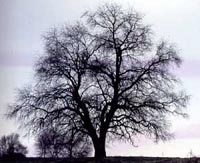Resource Library
Plant of the Week: Osage Orange (Bois d' arc, Hedge Apple, Horse Apple)
The University of Arkansas System Division of Agriculture does not promote, support or recommend plants featured in "Plant of the Week." Please consult your local Extension office for plants suitable for your region.
Plant of the Week
Osage Orange, Bois d' arc, Hedge Apple, Horse Apple
Latin: Maclura pomifera

Growing up on the prairies of Oklahoma, one of the first trees I learned was the hedge
apple or "bow dock" as we ungrammatically called it.
This tree was never seen as a single tree in my prairie home but in hedge rows where
it made a solid barrier about 40 feet tall and wide. The Osage Orange, better than
any other, tells the story of the struggle our forefathers endured as they settled
the last great section of this nation -- the Great Plains.
The Osage Orange is a member of the mulberry family and bears large, hard, yellow,
round fruit that reach five inches across that slightly resemble an orange, except
without a rind. It is a deciduous tree native to Arkansas and Texas which has become
widely naturalized throughout the eastern states. Immature trees are usually armed
with inch long spines.
French trappers were the first to encounter the tree which they named bois d’arc
because the native tribes used the tough wood to make their bows. The first tree Lewis
and Clark sent back east from St. Louis in 1804 was the "Osage Apple," a tree that
the French trader Pierre Chouteau had picked up from the Osage Indians 300 miles to
the south and west.
Thomas Nuttall, the first botanist to explore Arkansas, gave the tree its scientific
name after William Maclure (1763-1840), a philanthropist and printer who was a co-founder
of the Philadelphia Academy of Natural Science, where much early American natural
history work occurred.
As settlers moved from the timbered east to the treeless Great Plains they had a
problem. In the east they made their fences of stone or sawn lumber, both of which
were missing in the prairie. A movement began in the 1840s to encourage hedge row
plantings as a living fence -- and the thorny Osage Orange was a natural.
In his 1858 book, "Hedges and Evergreens," John Warden writes from Cincinnati that
"It is no longer a matter of experiment, whether the Osage Orange will make a fence
or not. It is a proved fact that ... a hedge can be grown in four years, so compact
that no kind of stock can pass it."
In 1855, 1, 000 bushels of seeds of Osage orange seeds were shipped from Texas and
Arkansas to Illinois at as much as $50 per bushel.
But this hedging movement was not the final answer to the farmers’ problem. After
the Civil War, northern steel mills cast about for new markets -- now that rifle barrels
were no longer needed. The answer arrived for both the steel mills and the Great Plains
settler in 1874 when barbed wire was invented by an Illinois farmer named J. F. Glidden.
By 1880, barbed wire did for the prairie states what computer chips did for Silicon
Valley. The tough Osage Orange did not go away with the invention of barbed wire,
it simply adapted. The farmer still needed fence posts and the prairie winds still
needed calming with wind breaks. By 1948, Kansas alone had 96,596 miles of Osage Orange
hedge row plantings.
Edgar Allan Poe would have loved the winter form of the Osage Orange, for its dark,
brooding branches seem to reverberate with the sentiment he often expressed in his
writings. In the summer, the glossy green leaves provide a clean appearance and good
shade. The tree is available from specialist nurseries, but they now sell thornless
male clones such as "Wichita" and "Pawhuska."
While few of us will -- or for that matter should -- go out and plant an Osage Orange
in our home landscape, the tree has a fascinating history and has made an important
contribution to settling the American West. For teachers seeking a tree for the schoolhouse
grounds that will survive without summer maintenance and still have an interesting
history, the tree is a natural.
By: Gerald Klingaman, retired
Extension Horticulturist - Ornamentals
Extension News - February 11, 2000
The University of Arkansas System Division of Agriculture does not maintain lists of retail outlets where these plants can be purchased. Please check your local nursery or other retail outlets to ask about the availability of these plants for your growing area.